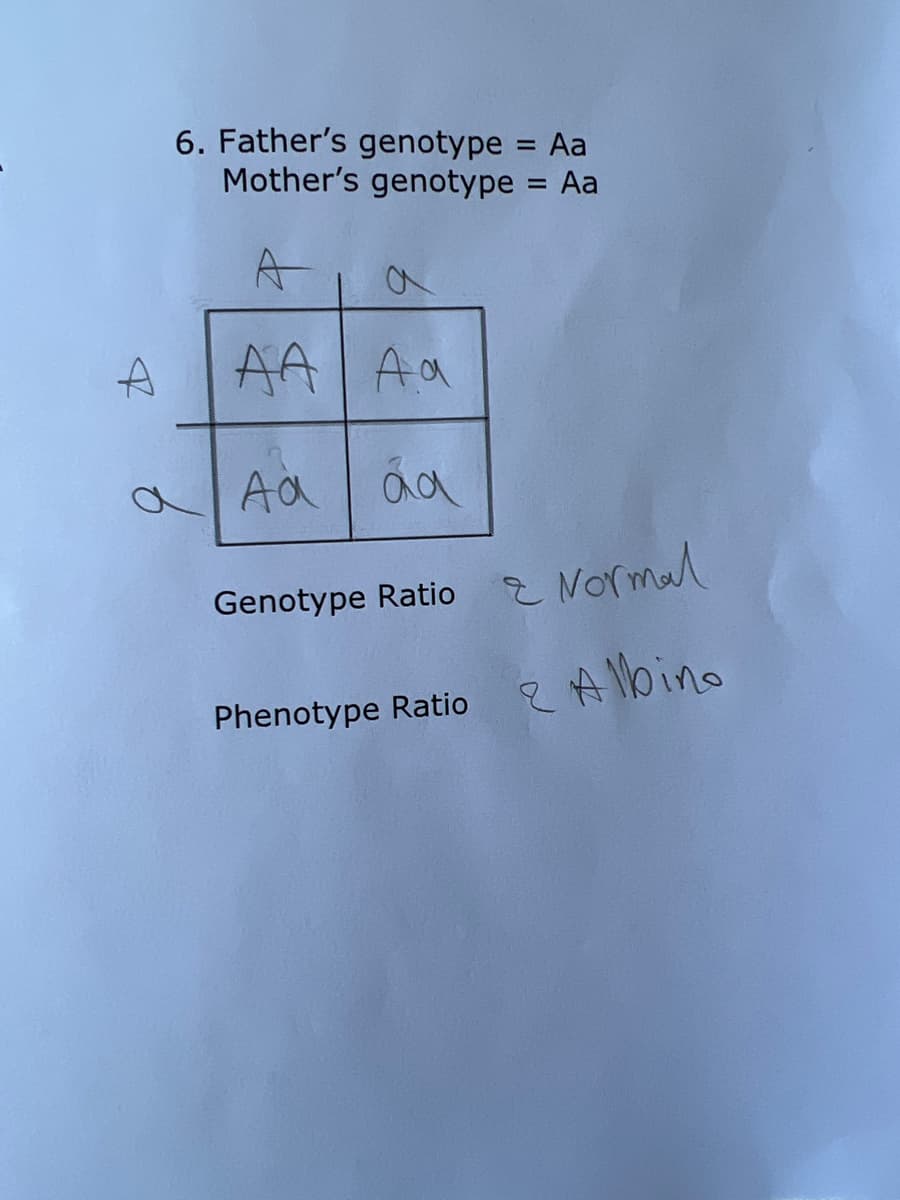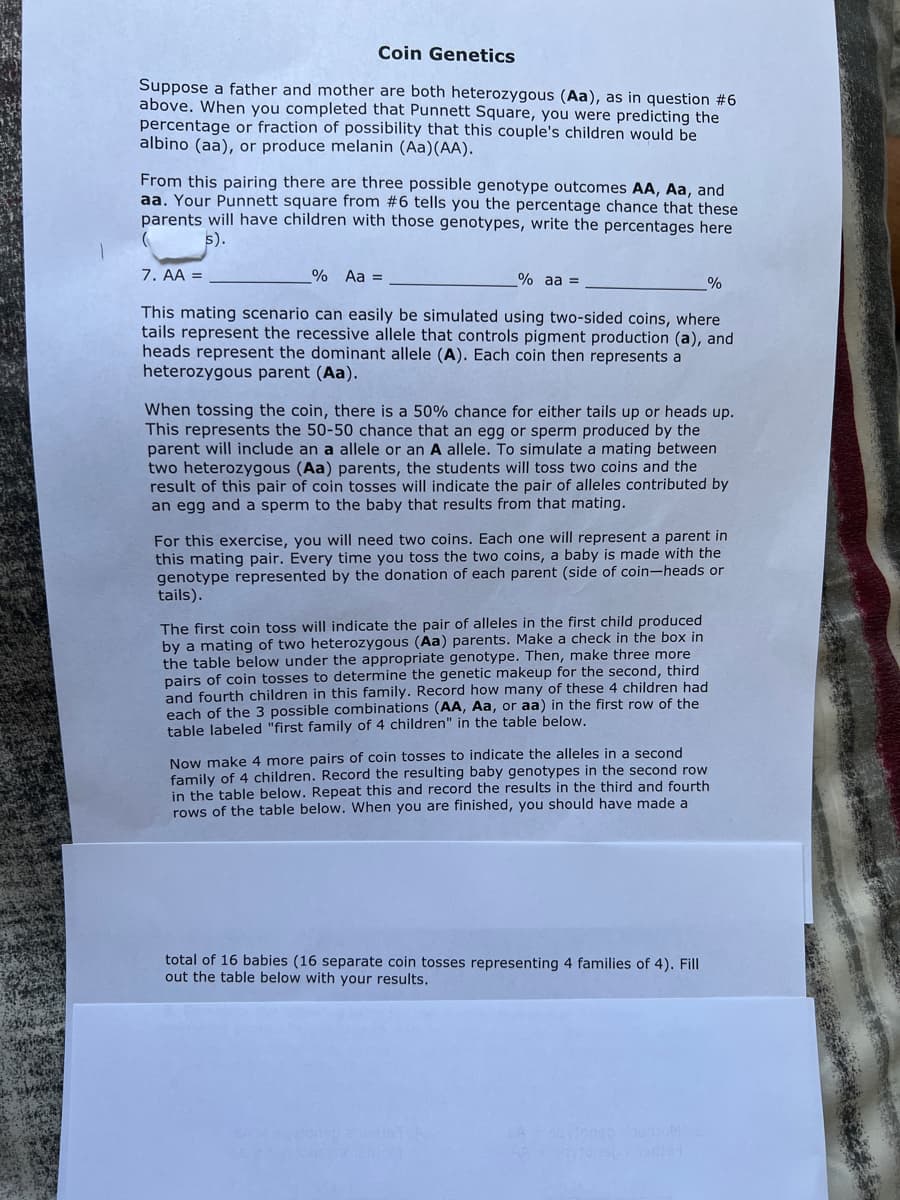From this pairing there are three possible genotype outcomes AA, Aa, and aa. Your Punnett square from #6 tells you the percentage chance that these parents will have children with those genotypes, write the percentages here 5). 7. AA = % Aa = % aa = %3D Thic mating cconario
From this pairing there are three possible genotype outcomes AA, Aa, and aa. Your Punnett square from #6 tells you the percentage chance that these parents will have children with those genotypes, write the percentages here 5). 7. AA = % Aa = % aa = %3D Thic mating cconario
Biology: The Unity and Diversity of Life (MindTap Course List)
15th Edition
ISBN:9781337408332
Author:Cecie Starr, Ralph Taggart, Christine Evers, Lisa Starr
Publisher:Cecie Starr, Ralph Taggart, Christine Evers, Lisa Starr
Chapter13: Observing Patterns In Inherited Traits
Section: Chapter Questions
Problem 5SQ: The offspring of the cross AA aa are ________. a. all AA b. all aa c. all Aa d. half are AA and...
Related questions
Topic Video
Question

Transcribed Image Text:6. Father's genotype = Aa
Mother's genotype = Aa
%3D
%3D
A
AA Aa
2 Normal
Genotype Ratio
Phenotype Ratio eA lbino

Transcribed Image Text:Coin Genetics
Suppose a father and mother are both heterozygous (Aa), as in question #6
above. When you completed that Punnett Square, you were predicting the
percentage or fraction of possibility that this couple's children would be
albino (aa), or produce melanin (Aa)(AA).
From this pairing there are three possible genotype outcomes AA, Aa, and
aa. Your Punnett square from #6 tells you the percentage chance that these
parents will have children with those genotypes, write the percentages here
5).
7. AA =
% Aa =
% aa =
%
This mating scenario can easily be simulated using two-sided coins, where
tails represent the recessive allele that controls pigment production (a), and
heads represent the dominant allele (A). Each coin then represents a
heterozygous parent (Aa).
When tossing the coin, there is a 50% chance for either tails up or heads up.
This represents the 50-50 chance that an egg or sperm produced by the
parent will include an a allele or an A allele. To simulate a mating between
two heterozygous (Aa) parents, the students will toss two coins and the
result of this pair of coin tosses will indicate the pair of alleles contributed by
an egg and a sperm to the baby that results from that mating.
For this exercise, you will need two coins. Each one will represent a parent in
this mating pair. Every time you toss the two coins, a baby is made with the
genotype represented by the donation of each parent (side of coin-heads or
tails).
The first coin toss will indicate the pair of alleles in the first child produced
by a mating of two heterozygous (Aa) parents. Make a check in the box in
the table below under the appropriate genotype. Then, make three more
pairs of coin tosses to determine the genetic makeup for the second, third
and fourth children in this family. Record how many of these 4 children had
each of the 3 possible combinations (AA, Aa, or aa) in the first row of the
table labeled "first family of 4 children" in the table below.
Now make 4 more pairs of coin tosses to indicate the alleles in a second
family of 4 children. Record the resulting baby genotypes in the second row
in the table below. Repeat this and record the results in the third and fourth
rows of the table below. When you are finished, you should have made a
total of 16 babies (16 separate coin tosses representing 4 families of 4). Fill
out the table below with your results.
Expert Solution
Step 1
A genotype is the set of genes that make up an individual.
Step by step
Solved in 2 steps

Knowledge Booster
Learn more about
Need a deep-dive on the concept behind this application? Look no further. Learn more about this topic, biology and related others by exploring similar questions and additional content below.Recommended textbooks for you

Biology: The Unity and Diversity of Life (MindTap…
Biology
ISBN:
9781337408332
Author:
Cecie Starr, Ralph Taggart, Christine Evers, Lisa Starr
Publisher:
Cengage Learning

Biology: The Unity and Diversity of Life (MindTap…
Biology
ISBN:
9781305073951
Author:
Cecie Starr, Ralph Taggart, Christine Evers, Lisa Starr
Publisher:
Cengage Learning

Biology: The Unity and Diversity of Life (MindTap…
Biology
ISBN:
9781337408332
Author:
Cecie Starr, Ralph Taggart, Christine Evers, Lisa Starr
Publisher:
Cengage Learning

Biology: The Unity and Diversity of Life (MindTap…
Biology
ISBN:
9781305073951
Author:
Cecie Starr, Ralph Taggart, Christine Evers, Lisa Starr
Publisher:
Cengage Learning